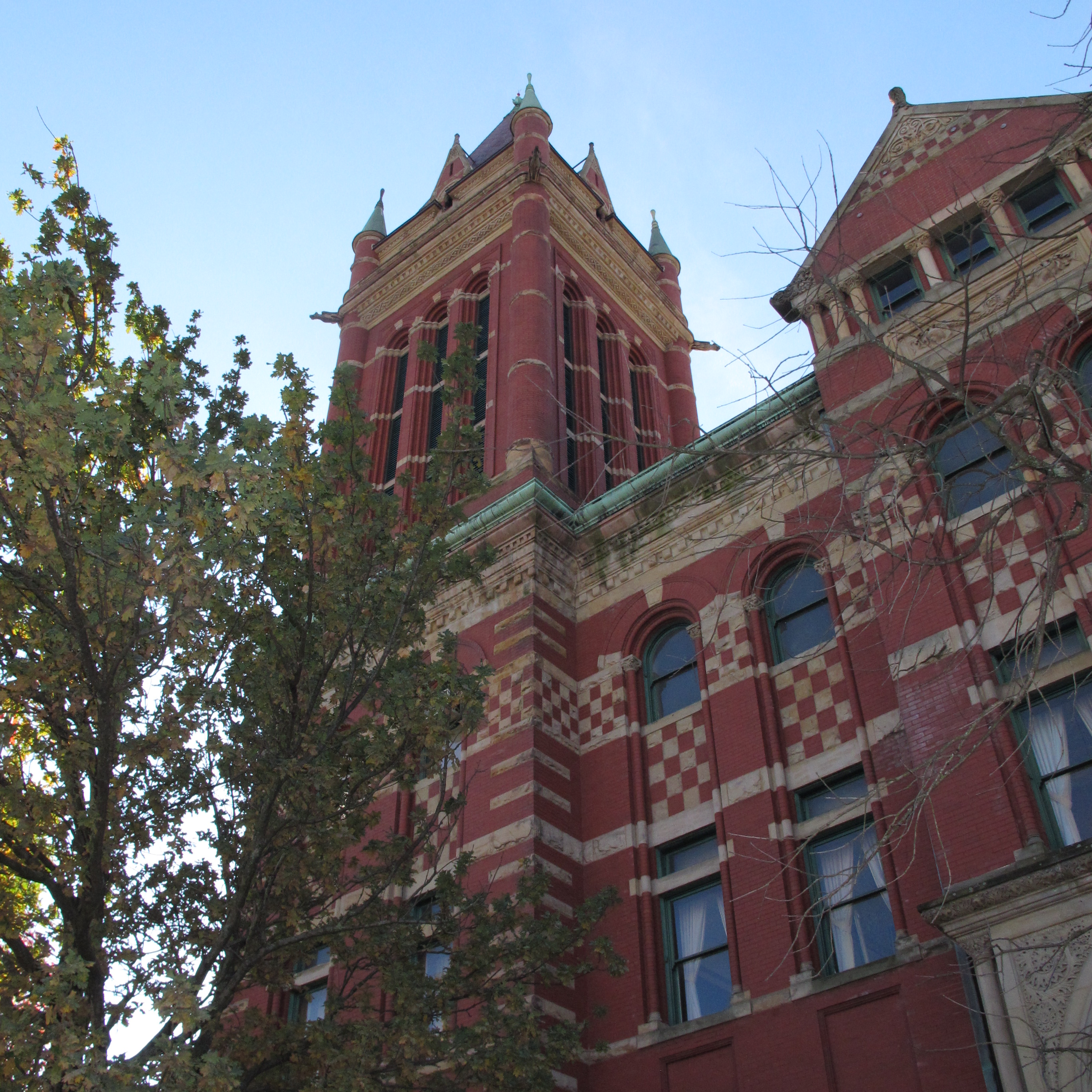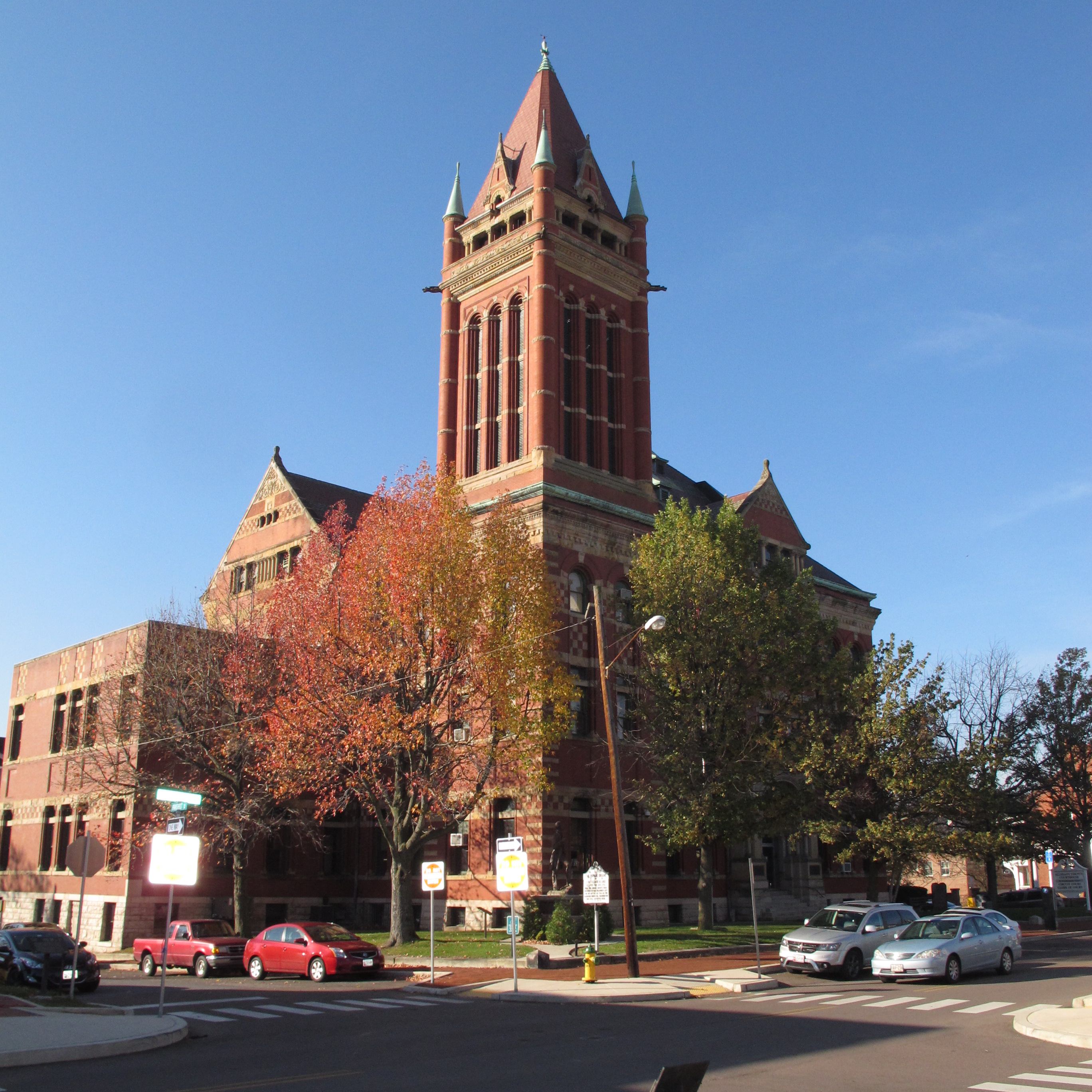In addition to the many builder-type, pattern book architecture that can be found in the threatened historic Rolling Mill neighborhood there are also a number of homes designed by prominent local architects.
WRIGHT BUTLER, ARCHITECT, ALLEGANY COUNTY COURTHOUSE
Renowned local architect, Wright Butler, was born as the son of a furniture manufacturer. Butler studied architecture at the Maryland Institute of Baltimore for three years beginning in 1888. At the Institute, Butler familiarized himself with fashionable architectural styles of the time like Richardsonian Romanesque and Queen Anne Architecture. Upon his return to Cumberland in 1891, the young architect opened an office, working mainly on residential designs.
In 1893, Butler received his first large commission, the Allegany County Courthouse, the most iconic building of Cumberland.
- The tower of Allegany County Courthouse, by Wright Butler, Cumberland, MD. Designed by local architect Wright Butler in 1893, the structure is an example of Romanesque architecture. Photo by Christopher M. Stevens.
- Main entryway of Allegany County Courthouse, Cumberland, MD. Designed by local architect Wright Butler in 1893, the structure is an example of Romanesque architecture. Photo by Christopher M. Stevens.
- The tower of Allegany County Courthouse, by Wright Butler, Cumberland, MD. Designed by local architect Wright Butler in 1893, the structure is an example of Romanesque architecture. Photo by Christopher M. Stevens.
- A photograph of Allegany County Courthouse in the Washington Street Historic District of Cumberland, MD. Designed by local architect Wright Butler in 1893, the structure is an example of Romanesque architecture. Photo by Christopher M. Stevens.
Other impressive Butler designs in Cumberland include: the Cumberland Masonic Temple, the Cumberland Liberty Bank Building, the George Troug House on Baltimore Avenue, and Butler’s own personal home at 205 Columbia Street which is listed on the National Register and is currently for sale!
Wright Butler designed the 2-story brick house at 227 Cecelia Street for Jonathan Dodd in 1912. Another version of the gable house, this architect-designed house sports a heavily articulated gable in the attic story. The gable is the prominent element in this house as it is in many Rolling Mill homes. It sports slate shingles in both rectangular and diamond-shaped patterns and a Palladian window. Butler included the over-sized double hung windows that he preferred in this period. The porch has been altered with the addition of a new brick porch.
AARON MAY, BUILDER
Aaron May, was a popular local builder who frequently worked with prominent local architects like Butler and George Sansbury. He built two Butler designs, the Dime Savings Bank at 76 Baltimore Street and the Commercial Savings Bank at 55 N. Liberty Street, for example. He also built a number of homes in Rolling Mill. The house he built at 212 Cecelia Street for Louis Ward is typical of many homes built between 1907 and 1911 in Cumberland. Built of exposed concrete block, which Wright Butler is believed to have first introduced to Cumberland, this 2-story concrete block house is another example of the gable house.
- 227 Cecilia Street in the Rolling Mill neighborhood of Cumberland, MD. It was designed by local architect Wright Butler, who also designed the Allegany County Courthouse. Photo by Christopher M. Stevens.
- Built by Aaron May, 212 Cecilia Street in the Rolling Mill neighborhood of Cumberland, MD. Photo by Christopher M. Stevens.
- Butler designed 408 Park Street in the Rolling Mill neighborhood of Cumberland, MD. Photo by Christopher M. Stevens.
- J.S. Seibert designed 404 Park Street in the Rolling Mill neighborhood of Cumberland, MD. Photo by Christopher M. Stevens.
J.S. SEIBERT, ARCHITECT & ENGINEER
Park Street opposite the now demolished Queen City Station was the home of many solid, middle-class citizens of Cumberland. Handsome two to three-story houses line the east side of the street. Wright Butler-designed both houses at 408 and 410 Park Street. J.S. Seibert designed 404 Park Street. J.S. Seibert, a civil engineering graduate of Lehigh University, operated a substantial architectural practice in Cumberland in the late 19th and early 20th centuries. Other impressive Seibert designs in Cumberland include: Rosenbaum’s Department Store on Baltimore Street and the McKaig Mansion at 528 Washington Street. The Butler and Siebert houses contribute to a pleasing streetscape. Employing gables, slate, dormers, wood, stone, and brick, these two architects accomplished harmonious groupings which possess variety and interesting details which give some indication of the earlier grandeur of Park Street.
THESE HOMES ARE THREATENED
The City of Cumberland and the Cumberland Economic Development Corporation, an instrumentality of City government, plan to demolish portions of the historic Rolling Mill neighborhood to build incompatible and economically unsustainable low-density sprawl. Proponents of demolition have suggested that the buildings are not historic; so in an effort to better understand what may be lost, we’ll be sharing short stories about many of these threatened properties. Unfortunately, the demolition plans for this neighborhood appear to extend to these historic architect designed homes as well. The plans call for new construction and surface parking in their place.








